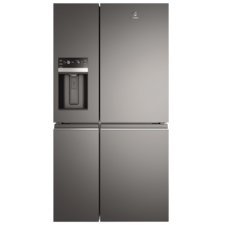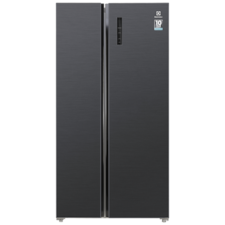Having correct refrigerator temperature settings not only helps you keep your food fresh, it also contributes to a more sustainable lifestyle in the process. Yet not everyone knows how to adjust refrigerator temperature or even how to understand the refrigerator temperature control properly.
No worries, we’ve got you covered. Read on to learn helpful advice from Electrolux experts.
What are the right refrigerator temperature settings to keep food fresh?
1. What temperature should a refrigerator be?
It's advised by the United States Food and Drug Administration (FDA) that ideal or normal temperature for 1 door refrigerators or fridges in general is at or below 4℃, while it is below -18℃ for freezers. For daily use, refrigerator temperature should be kept between 1.7 – 3.3℃ or close to freezing. This temperature range helps to slow down the growth of bacteria and prevent food from spoiling.
It is important to note that different parts of the refrigerator may have slightly different temperatures. It is a good idea to use a thermometer to check the temperature in different areas of the fridge. For example, the temperature in the door shelves may be slightly higher than the temperature in the back of the refrigerator.

Some default temperature settings for ideal food storage condition on modern refrigerators
2. What temperature should a freezer be?
As mentioned above, the ideal temperature for a freezer is -18°C or below. This temperature helps to keep food frozen and prevent the growth of bacteria and other microorganisms that can cause foodborne illnesses.
While refrigerator freezer temperature should be at or below -18°C, it is also important to keep the temperature as consistent as possible to ensure that the food stays frozen and safe to eat. It is recommended to use a thermometer to check the temperature in the freezer regularly and adjust the temperature settings as needed to maintain the proper temperature.
>>> Read the following articles to keep your refrigerator fresh for longer:
3. Should a refrigerator be set to min or max temperature?
A refrigerator should not be set at the minimum or maximum temperature. Setting the refrigerator temperature too low can cause your food to freeze, which can damage the texture and flavor of some foods. On the other hand, setting the temperature too high can lead to the growth of harmful bacteria and spoil your food.

A refrigerator should not be set at the minimum or maximum temperature but within a recommended range between 1.7 and 3.3°C
It is important to set the refrigerator temperature to the appropriate range of between 1.7-3.3°C and use a thermometer to ensure that the temperature remains consistent over time. If you're not sure about the right temperature setting for your refrigerator, refer to the user manual or contact the manufacturer for guidance.
How to check your refrigerator temperature?
Based on the ideal temperatures mentioned above, it’s important to know what temperature your fridge is maintaining. Modern fridges such as French door refrigerators or side-by-side refrigerators often have a digital temperature readout inside or sometimes even on the outside of the appliance, making such temperature checks super easy.

Digital temperature readout on latest refrigerators
If you don’t have a refrigerator with such a readout, we recommend that you buy a refrigerator thermometer. These are specifically designed for use with refrigerators, and you can find them in kitchen supply stores or online.
Place the thermometer in a place inside your refrigerator for which you want to monitor the temperature. Leave it there for a few hours before you take the first reading. You can then use this information to decide whether your refrigerator’s temperature control needs to be adjusted.
>>> Read more: How many watts an Electrolux refrigerator consumes per day
Understanding your refrigerator temperature controls
To make sure that your refrigerator is always at an ideal temperature, it’s very important that you learn how to use it correctly – and that means understanding the temperature controls. Depending on the make and model of your refrigerator, these controls can look quite different, but they usually work either with numbered or named power levels.
Where are the temperature controls on my refrigerator?
On most modern fridges, the temperature controls can be found on an interior control panel or on a slider control panel on the outside.
Some and have a temperature control found inside the freezer compartment, which controls both the freezer and refrigerator temperatures.

Temperature control inside the freezer compartment
In some older models, the temperature control may be at the bottom or back of the refrigerator. This control may be a dial or slider, and it may be labeled with temperature ranges or numbers.
How do you use refrigerator temperature controls with numbers?
Usually, the numbers on your refrigerator’s temperature controls don’t directly correspond to temperature. That means that if you set your refrigerator to “1”, it will not automatically cool the inside of the appliance to 1 degree.
Most often, these numbers are power levels ranging from 1 to 5 or 9, with the highest number standing for the highest power level.
>>> Read more: FAQs about refrigerators

Temperature controls with numbers on a freezer
How do you use refrigerator temperature controls labeled with words?
If your refrigerator temperature controls are labeled with words such as "cold," "colder," or "coldest,", or “low”, “medium”, and “high”, you should first refer to the user manual. See if it provides guidance on how to use the temperature controls.
It may also give recommendations for the best setting for different types of food. If you’re unsure, start with the middle setting, which is often labeled as "normal" or "recommended."
>>> Helpful food storage tips:
- How to store vegetables and fruits in the refrigerator
- 8 tips for how to store beef in the fridge and freezer
Extra tips to keep your refrigerator cool
To make sure the temperature inside your refrigerator stays evenly cool, it is important to make sure that the appliance is not overloaded, as this can interfere with the circulation of air and cause some areas to be colder than others. It’s also a good idea to keep the refrigerator door closed as much as possible so the cold air can’t escape.
Latest refrigerators from Electrolux offers a wide variety of technologies that help you keep your refrigerator cool and your food fresh and tasty.
The EvenTemp technology minimizes temperature fluctuations by cooling each shelf individually, creating a more consistent temperature. TwinTech Cooling keeps temperature and humidity levels stable while QuickChill lets you cool large amounts of fresh food quickly.
Electrolux UltimateTaste 900 refrigerator offers ideal storage with 5 temperature settings
If you are on the market for a new fridge, learn helpful refrigerator buying tips here or take a look at our best-selling Electrolux refrigerators below:
- TasteSealFlex ideal storage with 5 temperatures.
- TasteLockAuto keeps vegetables fresh for 7 days*.
- TwinTech cooling help preserves taste and texture.
- NutriFresh inverter compressor saves energy.
- TasteLock keeps vegetables fresh and tasty.
- TasteGuard keeps your fridge smelling fresh*.
- NutriFresh inverter compressor saves energy.
- TasteLock keeps vegetables fresh and tasty.
- WaterStream for chilled water through the door.
- TasteLockPlus keeps vegetables fresh for 7 days*.
- EvenTemp reduces temperature fluctuations.
- ChillRoom is ideal for meat, cheese, and snacks.
Discontinued
- TasteSeal keeps fish for 7 days* without freezing.
- TasteLockAuto keeps vegetables fresh for 7 days*.
- EvenTemp reduces temperature fluctuations.
FAQs about refrigerator temperature
-
What is the normal refrigerator temperature?
The recommended temperature for a refrigerator is between 1.7-3.3°C. However, some refrigerators can go lower than this temperature.
-
What is the right refrigerator freezer temperature?
The recommended temperature for a freezer is between -18 to -15°C. It's not recommended to set your freezer to the coldest setting as it can cause ice buildup in the freezer. It can also cause your freezer to work harder than it needs to, which can increase your energy bills and potentially shorten the lifespan of your appliance.
-
How can I check the temperature in my refrigerator?
You can use a refrigerator thermometer to check the temperature in your refrigerator. Place the thermometer in the main compartment or in the area where you want to monitor the temperature.
-
Why is it important to monitor the temperature in my refrigerator?
Monitoring the temperature in your refrigerator is important to ensure that your food stays fresh and safe to eat. A temperature that is too warm can cause food to spoil, while a temperature that is too cold can freeze certain foods and affect their quality.
-
How often should I adjust the temperature controls on my refrigerator?
You should adjust the temperature controls on your refrigerator as needed, based on the temperature readings and your specific needs. Check the temperature periodically and adjust the controls if necessary.





